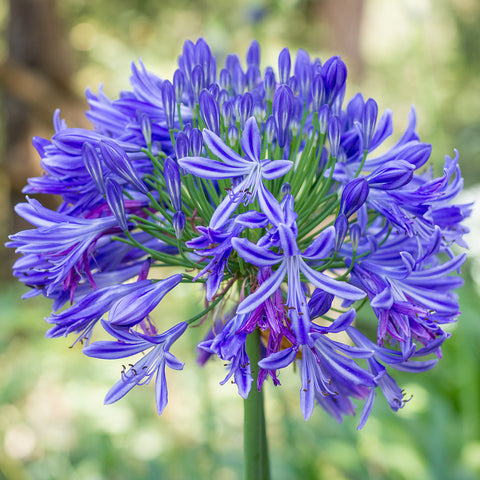Mastering the Art of Agapanthus Treatment: Important Steps for Healthy Growth and Dynamic Flowers
In the world of horticulture, the farming of agapanthus stands as a satisfying endeavor for those who seek to nurture these classy blooming plants. With their striking flowers and stylish foliage, agapanthus has actually caught the focus of gardeners worldwide. Nonetheless, accomplishing optimal growth and vivid blossoms needs a nuanced technique that encompasses various important actions. From choosing the best range to understanding pruning techniques, the trip towards cultivating thriving agapanthus plants is multifaceted and holds the crucial to unlocking the full capacity of these herb gems.

Picking the Right Agapanthus Variety

When selecting the ideal Agapanthus selection for your yard, consider aspects such as climate suitability, blossom shade, and development behavior. Furthermore, take into consideration the climate in your region to make sure the Agapanthus variety you select can prosper in your details problems. Understanding the development routine of different Agapanthus selections is vital for correct placement within your yard.
Suitable Growing Problems
Thinking about the optimum ecological needs is essential for effective Agapanthus growing. Agapanthus plants are sensitive to cold temperature levels and need to be secured from frost throughout wintertime months.
To ensure healthy development and lively blooms, plant Agapanthus light bulbs at a depth of about 2-4 inches and space them 8-12 inches apart. Mulching around the base of the plants helps retain moisture and subdues weed growth.
Watering and Feeding Tips
Preserving correct wetness degrees and offering essential nutrients are essential components in the care regimen for Agapanthus plants. When it comes to sprinkling Agapanthus, it is essential to strike an equilibrium. These plants favor regularly wet dirt yet are prone to root rot if overwatered.
Feeding Agapanthus is crucial for promoting healthy and balanced development and prolific flowers. Use a well balanced fertilizer, such as a 10-10-10 formula, in the very early spring as brand-new development arises. Repeat this application every 6-8 weeks throughout the growing period. Prevent too much fertilization, as it can lead to lush foliage at the expenditure of blooms. Constantly comply with the producer's instructions for appropriate dilution and application methods. By following these watering and fertilizing tips, you can ensure your Agapanthus plants thrive and produce lively, resilient blossoms.
Pruning Methods for Agapanthus
Pruning Agapanthus plants at the suitable times and with correct techniques is critical for preserving their health and wellness and advertising optimal growth and blooming. The ideal time to trim Agapanthus remains in late wintertime or early spring before new growth emerges. Beginning by removing any type of dead or yellowing leaves near the base of the plant. Cut them as close to the ground as feasible without harming the emerging shoots.
Deadheading spent flowers can likewise redirect the plant's power right into generating more flowers rather than this article setting seeds. If you want to collect seeds for breeding, leave some flowers to mature and completely dry on the plant.
Remember to make use of tidy, sharp tools to make precise cuts and lower the risk of presenting diseases. Agapanthus. Regular trimming will certainly help keep your Agapanthus looking healthy and cool while guaranteeing an abundant display of gorgeous flowers
Taking Care Of Common Pests and Illness
After making sure proper trimming methods for Agapanthus, it is necessary to attend to usual parasites and conditions that can affect the health and wellness and vitality of these plants. Agapanthus plants are normally hardy but can still succumb to certain problems. One typical insect that impacts Agapanthus is the Agapanthus gall midget. This little, see it here orange fly lays its eggs in the foliage, leading to altered development and blossom buds that fail to open. To battle this bug, trim and destroy any kind of afflicted plant components and think about making use of insecticidal soap.
Additionally, Agapanthus plants can endure from root rot if they are grown in inadequately draining soil. By being attentive and taking prompt action against diseases and insects, you can assist your Agapanthus plants prosper and generate vivid blooms. Agapanthus.

Verdict
In conclusion, understanding the art of agapanthus treatment involves picking the best range, supplying optimal growing problems, proper watering and feeding, ideal pruning techniques, and addressing common parasites and conditions. By complying with these crucial steps, you can make certain healthy development and vivid flowers for your agapanthus plants. Remember to consistently keep track of and preserve your plants to promote their general well-being and long life.
To guarantee healthy and balanced development and vivid flowers, plant Agapanthus light bulbs at a depth of regarding 2-4 inches visit here and area them 8-12 inches apart. By adhering to these watering and fertilizing suggestions, you can guarantee your Agapanthus plants prosper and produce vivid, lasting flowers.
One usual bug that influences Agapanthus is the Agapanthus gall midge. In addition, Agapanthus plants can suffer from root rot if they are grown in inadequately draining dirt. By following these important actions, you can make certain healthy and balanced development and lively blooms for your agapanthus plants.